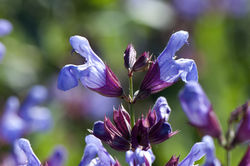Green Fingers in the Autumn
At Caves Folly Nursery in Colwall, Bridget is tidying the garden and enjoying some later bloomers.
What an amazing summer we have had, the fruit is so abundant that branches are breaking under the weight! Autumn is a stunning season as well as being such a busy time in the garden and on the nursery.
Don’t be in too much of a rush to dead head all those perennials and sweep up all those leaves, as these untidy looking plants are a vital source of bedding and food for wildlife which will help increase their chances of surviving winter.
There are lots of late flowering plants that will provide colour and food for insects right up to December.
Aster varieties are available in a huge array of sizes and colours, flowering from July through to the first hard frosts. Rudebeckia, Trycirtis, Helianthus, Heleopsis, Helenium, Sedum, Ligularia, Penstemon, Salvia, Perovskia and Bidens are all late flowering perennials.
Trees and Shrubs are also important for providing shelter and food for wildlife. Trees such as Birch with flaking bark will act as overwintering homes to many insects, which in turn provide a handy natural bird table for birds such as the Tit family. Trees such as Corylus, Malus, Rowan and Crataegus provide nuts and berries for birds such as Blackbirds, Finch, Redwings and Fieldfares.
These autumn feasts provide the birds with essential food to build up their energy reserves for winter. If you are feeding the birds in your garden switch the food you provide from protein-rich, such as nuts, to high-energy foods such as fat balls which will help birds build energy reserves for long migrations or winter survival.
A recent study found that honeybees rely on ivy during the autumn months. Up to 89% of the pollen they collect is from ivy’s tiny green flowers, seldom noticed by gardeners. Where possible, allow mature ivy to flourish in your garden, especially in amongst hedgerows and on tree trunks.
Enjoy your autumn!
Bridget
01684 540631


